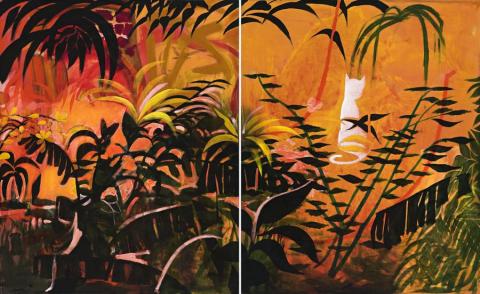RED GARDEN, c.1970
CHARLES BLACKMAN
synthetic polymer paint on canvas (diptych)
211.0 x 346.0 cm (overall)
signed lower left, left panel: BLACKMAN
Private collection, Sydney, acquired directly from the artist c1978
Amadio, N., Charles Blackman The Lost Domains, Alpine Fine Arts Collection, New York, 1980, pp. 92–93, cat. 6.15 (illus. double page)
'The Blackman Garden is very often frequented by a white cat, which is a symbol of many things: innocence, childhood, a familiar, a night-self visiting secret places - the enchanted gardens of memory.'1
The enigmatic white cat of Red Garden is a frequent character in Charles Blackman's highly celebrated garden scenes. Replacing the iconic figures from the Alice and Schoolgirl series, Blackman employs the white cat as an allegory of innocence and youth. Throughout the garden series we are offered various glimpses into the daily life of the white cat, who in this instance sits with its back to the viewer. Partly ensconced by the plants and trees, the cat is deeply engaged by something or someone that we cannot see and like many of the figures in the Schoolgirl series, the cat's facial features are concealed, providing an air of mystery. Combined with the absence of a horizon and the enhanced vivid colours that radiate from the large golden sun, there is a surreal quality to this painting as Blackman explores the fairytale land of the white cat's garden.
With its haunting beauty and lush foliage, Red Garden entices the viewer into the landscape which is simultaneously foreign and familiar, arousing nostalgic memories of one's youth. This is the overgrown garden of our childhood imagination, an exotic jungle where mysterious creatures prowl and exciting adventures await. It is as if we have stepped into a somewhat wilder version of the hidden garden in Frances Hodgson Burnett's classic novel The Secret Garden; a forbidden but magical place. The garden plays an integral role in Blackman's oeuvre, as a theme evocative of the fantasy world explored in the Alice in Wonderland series: 'For him, it is a garden - the domain he lost some time in his childhood and has been painting his way back to ever since.'2
Blackman's garden series originally drew inspiration from Claude Monet. Like Monet, Blackman began to depict the same subject at various times of the day, experimenting with the effect of light. Some scenes are depicted during the day, others in the evening whilst Red Garden is illuminated in a warm dusk light that pervades the canvas as dark leaves and foliage spread across the foreground. However, as demonstrated in the picture on offer, Blackman's use of colour and the formation of his shapes are very different to Monet's soft muted tones and impressionist brush strokes. As Blackman continued to explore this theme 'the garden acquires a crisper look, with cut-out shapes and unreal colours ensuring a disengagement from nature'.3
The magical world of the cat's garden provided a great source of inspiration for Blackman and the pure imagination of this series resonates strongly with the viewer: 'I was trying deliberately to create a sense of unreality, of it being in the cat's garden with no human being in it. A world shut off from everything else. It's funny, while I was working on it, my daughter Christabel came home from the library with a book, and started reading me a story about a cat stepping into a wardrobe and out into his own garden. The wardrobe was the only possible entrance. I don't say I'm psychic or anything, but the two did coincide.'4
1. Amadio, N., Charles Blackman: The Lost Domains, Alpine Fine Arts Collection, New York,1980, p. 80
2. Ibid.
3. St John Moore, F., Charles Blackman: Schoolgirls and Angels, National Gallery of Victoria, Melbourne, 1993, p. 11
4. Hall, S., 'Blackman - Ten Years After the Antipodean Affair', Bulletin, 5 July 1969, p. 32
CASSI YOUNG
